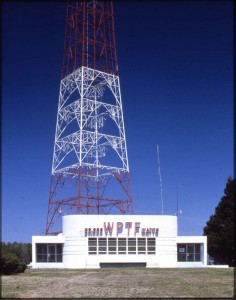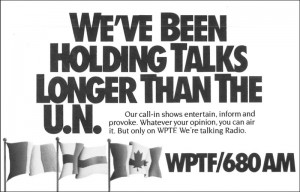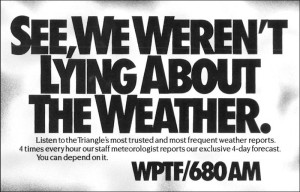WFBQ were the sequentially issued call letters assigned to a new broadcast station in Raleigh, N.C. when the Radio Division of the Bureau of Navigation, Department of Commerce granted a license to the Wynne Radio Company on October 25, 1924. The retail radio parts and supplies firm was located at 226 ½ Fayetteville Street, in a three-story brick business structure in downtown Raleigh. WFBQ, assigned 252 meters (equal to 1190 kilocycles), made its air debut with 50 watts of power from the third floor of the building on October 25, 1924, upon receipt of its “Class A” broadcast license.
On August 10, 1925, WFBQ was authorized to change its call letters to WRCO. Two days later, on August 12th, power was increased to 100 watts, and the new call letters made their first appearance. In late 1926, the station, without governmental authorization to do so, increased power to 250 watts. By April of 1927, when new radio regulation took effect, the Wynne Radio Company shifted its WRCO back to 100 watts on 1190 kilocycles. In the spring of 1927, the station was moved to newer quarters at 8 West Hargett Street, a two-story business structure known as the Pizer Brothers Company building (number 8 now houses a wig shop). WRCO was assigned to operate on 1380 kilocycles and to raise power to 250 watts by the Federal Radio Commission in June of 1927.
WRCO was sold by the Wynne interests on August 27, 1927, to the Durham Life Insurance Company, concurrently changing frequency to 720 kilocycles, raising power to 500 watts, and changing call letters to WPTF, signifying the firm’s slogan, “We Protect The Family.” In early 1928, the station was assigned to operate on 550 kilocycles, and power was doubled to 1,000 watts. By the end of 1928, the WPTF Station Director was J.S. Barnes. Studios were moved to the Durham Life Insurance Building at 324 Fayetteville Street in late 1928. As a result of a nationwide frequency reallocation plan placed into effect by the FRC, at 3 a.m., Saturday, November 11, 1928, WPTF was shifted to a new dial position – 680 kilocycles – to be shared at night with KPO at San Francisco. When the San Francisco station was silent, the Raleigh station could operate. Most evenings, WPTF was silent while KPO, the dominant Clear Channel station, was on the air.
On May 15, 1929, WPTF joined the National Broadcasting Company’s “chain,” becoming the only NBC affiliate in North or South Carolina at the time. By April 1930, H.K. Carpenter was named Station Director. By 1931, WPTF’s transmitter and towers were relocated to the roof of the eleven-story Sir Walter Raleigh Hotel building at 400 Fayetteville Street (the building is now known as The Hotel Sir Walter). Studios continued to be located at 324 Fayetteville Street. The station was now in daily operation from 6:30 a.m. to local sunset in San Francisco (L – KPO on 680 kilocycles).

WPTF was transferred on March 18, 1933, to the WPTF Radio Company, a newly formed subsidiary of the Durham Life Insurance Company. On May 9, 1933, the station was granted FRC permission to raise power from 1,000 to 5,000 watts during daylight hours and to move its transmitter locally. Power was raised effective June 10, 1933, to 5,000 watts during the day and 1,000 watts during the night from a new transmitting site in Cary, N.C., some seven miles west of Raleigh. Two new 370-foot Ideco towers were installed there to support the station’s antenna.
Richard H. Mason was named Station Director of WPTF in 1934. On June 15, 1935, one of WPTF’s two towers was blown down in a storm. Two new self-supported Ideco vertical radiators were soon erected at the Cary site, anticipating directionalized operation. In August 1935, the NBC-affiliated station increased nighttime power to 5,000 watts, matching the daytime power output, and began directional operation during nighttime.

In the 1970s, WPTF continued to grow as a full-service radio station with Music, News, Sports, and Weather. After long-time morning personality (and sports play-by-play man) Bill Jackson died, Maury O’Dell began his tenure as the Morning Show Host.
WPTF-FM became a trendsetter by becoming the first Album Oriented Rock Station in the United States and switched its call letters to WQDR.
The company also purchased a UHF TV station, WRDU. The call letters were changed to WPTF-TV, and it became the NBC affiliate for the Raleigh-Durham area.
In the early 1980s, Carl Venters, Jr., resigned from his position to establish his own company along with a new partner, Jack V. McCarthy. Durham Life Broadcasting entered into a merger with the Curtis Radio Group. Two new stations WEWO and WSTS joined the Durham Life family of stations, and Donald Curtis became Chief Executive Officer. Curtis remained in this role for two years before also resigning to re-establish his own company again.

In 1991, Durham Life decided to exit the broadcasting business. Donald Curtis led a group in purchasing all of the Durham Life Stations. Curtis immediately sold the TV stations to a group headed by Paul Brissette, a Wilmington area broadcaster, while Curtis took over the ownership of WPTF, WQDR, WMXF, and WEWO and renamed his company the Curtis Media Group.
Today, WPTF is North Carolina’s second-oldest continuously licensed broadcast station. WPTF operates 24 hours a day on 680 kHz with 50,000 watts (nighttime directional). Until 1987, studios were in the WPTF building at410 South Salisbury Street in Raleigh, N.C., with transmitter and towers located in Cary, N.C. In 1987, WPTF moved to its current studio site in Highwoods in North Raleigh.
